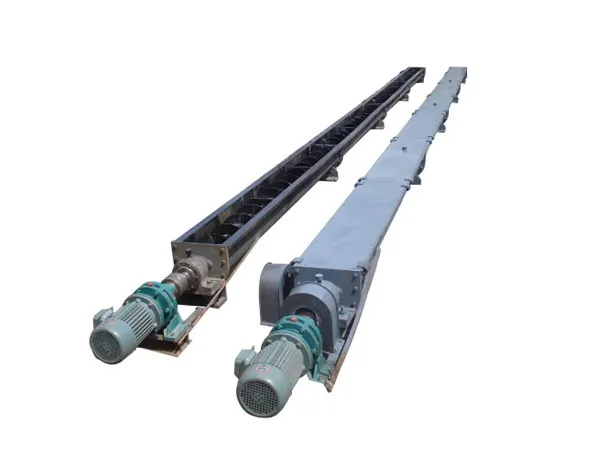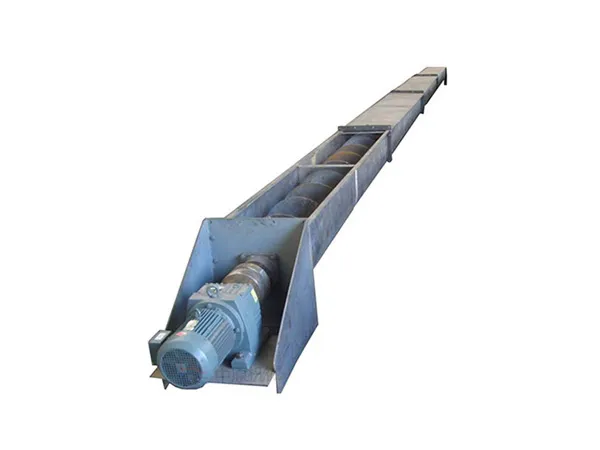

-
Products
-
Application


Choosing the right screw conveyor is critical for ensuring efficient and reliable material handling in various industries. Whether you're moving fine powders, granular materials, or semi-solid waste, selecting a conveyor that matches your specific application can enhance productivity, reduce maintenance costs, and prolong equipment life. With numerous configurations, materials, and designs available, it can be overwhelming to find the perfect fit. This guide will walk you through the essential factors to consider when choosing a screw conveyor, including material type, capacity, angle of inclination, and operational environment, helping you make a well-informed decision tailored to your needs.

Material Name: Be specific (e.g., "Portland Cement," "Soybean Meal," "Wet Sand").
Bulk Density: Weight per unit volume (e.g., lbs/ft³ or kg/m ³). Essential for capacity calculations and power requirements.
Particle Size & Distribution: Is it fine powder, granular, pellets, lumpy, stringy? Give minimum, maximum, and average sizes if possible.
Flowability: How easily does it flow? (e.g., free-flowing, sluggish, sticky, fluidizable). Look up its Angle of Repose if possible.
Abrasiveness: Does it wear down equipment? (e.g., sand, alumina are highly abrasive). This dictates material choices for screw and trough.
Corrosiveness: Does it chemically attack materials? (e.g., acids, salts). Affects material choices (stainless steel grades, special coatings).
Temperature: Operating temperature of the material. Affects material selection, bearing/seal types, and potential expansion/contraction.
Moisture Content: Can significantly affect flowability, stickiness, and corrosiveness.
Friability: Is the material easily broken or degraded? May require slower speeds or specific flight designs.
Special Characteristics:
Hygroscopic: Absorbs moisture from the air.
Explosive/Flammable: Requires specific safety measures (explosion-proof motors, grounding, proper sealing).
Toxic/Hazardous: Requires containment (fully enclosed, specific seals).
Food Grade/Sanitary: Requires specific materials (stainless steel), finishes (polished), and design features (easy-clean, no crevices).
Sticky/Builds Up: May necessitate shaftless design, special coatings, or specific flight types.
Rate: How much material needs to be moved per unit of time? Specify units clearly (e.g., tons per hour (TPH), kg/min , cubic feet per hour (CFH), m³/hr).
Basis: Is the rate based on weight or volume? Be consistent. If based on weight, you need the bulk density to convert to volume for sizing.

Conveying Distance: The horizontal (or inclined) length from the center of the inlet to the center of the outlet.
Inclination Angle: Is the conveyor horizontal (0°) or inclined? Inclines significantly reduce capacity and increase power requirements. Specify the angle accurately. Vertical conveyors (90°) are a special category.
Inlet(s) & Outlet(s):
Number and location of inlets and outlets.
Type of connection required (plain end, flanged, special adapter).
Operating Environment:
Indoor/Outdoor: Affects material choice, need for covers, motor enclosure type.
Ambient Temperature Range: Affects component selection.
Atmosphere: Dusty, wet, corrosive?
Shafted Screw Conveyor: Most common. A central pipe supports the screw flights. Suitable for most powders, granules, and non-stringy materials. Requires hanger bearings for longer lengths.
Shaftless Screw Conveyor: No central pipe. The screw spiral itself transmits torque. Ideal for sticky, stringy, lumpy, or wet materials that might wrap around or clog a shafted conveyor. Can convey further without hanger bearings.
Vertical Screw Conveyor: Used for lifting material vertically. Requires higher speeds, specific inlet feeding, and often a tubular housing. Capacity calculation is different.
Flexible Screw Conveyor: A spiral (often shaftless) rotating within a flexible tube. Good for multiple planes, curves, and shorter distances/lower capacities.
Screw Diameter & Speed: Determined by the required capacity, material characteristics, and trough loading percentage (typically 15%, 30%, or 45% full depending on material). Suppliers usually calculate this using established standards (e.g., CEMA - Conveyor Equipment Manufacturers Association). Generally, larger diameters run slower, smaller diameters run faster for the same capacity. Slower speeds are better for abrasive or friable materials.
Screw/Flighting Material & Type:
Material: Carbon Steel (most common), Stainless Steel (304, 316 for corrosion/food grade), Abrasion-Resistant Steel (AR Plate for abrasive materials).
Flight Type:
Standard Pitch (Pitch = Diameter): Most common.
Short Pitch (Pitch < Diameter): Used for inclines, better feeding.
Variable Pitch: Often used at inlets for better feed control.
Cut Flights / Cut & Folded Flights: For mixing/agitation.
Ribbon Flights: For sticky materials.
Paddles: For mixing.
Flight Thickness: Heavier thickness for abrasive or dense materials.
Trough Type & Material:
Type: U-Trough (most common, easy access), Flared Trough (wider top), Tubular Housing (enclosed, better containment, stronger). Jacketed troughs for heating/cooling.
Material: Typically matches the screw (Carbon Steel, Stainless Steel, AR Steel liners).
Covers: Flanged, hinged, gasketed for dust/weather tightness. Consider safety grating over inlets.
Drive Assembly:
Motor: Sized based on torque requirements (calculated from capacity, length, inclination, material friction). Consider energy efficiency, voltage/phase, and enclosure type (TEFC, Explosion Proof).
Gear Reducer: Shaft-mounted or screw conveyor drive type. Ratio selected to achieve the desired screw speed.
Drive Location: Typically at the discharge end, but can be at the inlet.
Variable Speed: Needed if capacity needs adjustment? (Requires VFD - Variable Frequency Drive).
Hanger Bearings (for Shafted Conveyors):
Material: Wood (self-lubricating, simple), Bronze, Hard Iron (abrasion), Plastics (UHMW, Nylon - food grade/corrosion), Ball/Roller Bearings (higher load/speed, require sealing).
Lubrication: Consider accessibility and potential material contamination.
Seals:
Shaft Seals: Packing glands, lip seals, air/nitrogen purged seals. Crucial for fine powders, hazardous materials, or preventing contamination.
Inlets/Outlets: Design based on mating equipment (hoppers, chutes, other conveyors). Consider slide gates if flow control is needed.

Duty Cycle: Continuous (24/7) or intermittent operation? Affects component selection durability.
Safety: Ensure proper guarding (drive, screw access), emergency stops, lockout procedures.
Maintenance & Accessibility: How easy is it to inspect, clean, lubricate, and replace wear parts (flights, bearings, seals)?
Dust Control: Requirements for covers, seals, and potential dust collection points.
Noise Levels: Any specific limitations?
Budget: Balance initial cost with expected lifespan, maintenance costs, and operational efficiency.
Provide potential suppliers with ALL the detailed information gathered above. The more detail you provide, the better the quote and the more likely the conveyor will perform correctly.
Discuss your application with their engineers. They have experience with various materials and configurations.
Compare quotes not just on price but on the specifications offered, material quality, and component robustness.
By systematically working through these steps, you can define your requirements clearly and select a screw conveyor that is properly sized, constructed, and configured for your specific application.

Official Agent of ZY MINING in Russia.
Please enter here.
Add: Luoxin Industrial Zone,Luoyang City,Henan Province P.R.C.
Tel: +86-379-67313306
E-mail: gloria@zyksjx.com